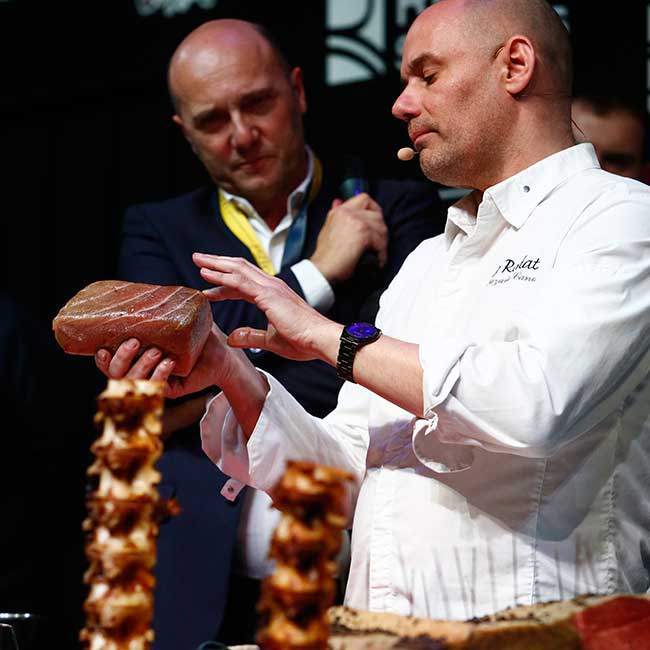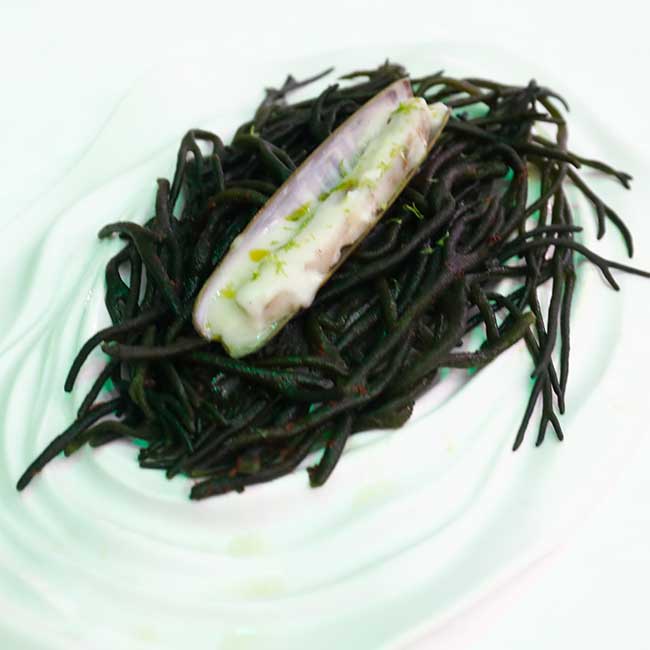.png.transform/rendition-xs/image_image%20(1).png)
The Ecological Trend from Spain That is Leaping From the Seas Into the Frying Pan
By using parts of previously discarded fish and recycling the plastic that floods our seas, new strategies of haute cuisine are committing to sustainability.

As if they aren’t piping hot, chef Nazario Cano, from the restaurant El Rodat, in Jávea, lifts up hot, steaming cloths with his bare hands. The cloths wrap a large piece of bluefin tuna mixed with aromatic herbs – an symphony of aromas based on fennel, orange blossom water and lemon leaves. He applies pressure and waits exactly four minutes, for he knows that in the kitchen the details are all in the precise measurement of time.
“It’s at six degrees”, Nazario Cano explains in the kitchen mounted on the main stage of Reale Seguros Madrid Fusión, where this year there have been different talks on the best-kept secrets of certain marine species and the conservation of the marine environment. This necessity is beginning to seep into the consciousness of chefs, consumers and fishermen, ever more aware that the bobbing soup of microplastics we are turning our seas and oceans into is finding its way from the digestive system of fish to our stomachs.
Is this cutting edge? I don’t know. We want to innovate with flavours and textures,” Cano stresses before embarking on another recipe. The second dish he makes is a tuna bone-marrow consommé made with an ‘unused’ piece, with which Cano has been experimenting for some years now.

The use of underappreciated and discarded parts of the fish dovetails with sustainability, a trend that is beginning to hold sway naturally in high gastronomy and is part a ‘rule change’ in the discourse of chefs and gastronomy critics.
“To know the product you need to study it,” says Ekaitz Apraiz, a chef at Tunateca, one of the new gastronomic spaces in Barcelona where fish is one of the primary ingredients. “Our quest is to search for and work with new parts of bluefin tuna and bring it to customers, but always applying a criteria of traceability, sustainability and excellence,” the chef explains.
Apraiz shows two of these parts of a bluefin tuna which were traditionally thrown away and are now retrieved and used with purpose, serving as a core element in some of his creations. He talks about the ‘ear’ (a part close to where the ear should be given that tuna don’t have them) and the anal fin (“a part which is normally discarded and found under the spine and cooked on a low heat, like beef,” he explains). “These two pieces were discarded and now we eat them,” he said. “The ‘ear’ is the little flap at the jaw, an anatomical element of the tuna that lets water flow towards the gills. This thin gelatinous protrusion has a texture similar to pig’s trotters,” he explains. “With the anal fin we can make a ‘Peking Tuna’, due to its similarities with crispy roast duck, and the delicious nuances of mountain and sea”.
Tuna and other highly appreciated species unfortunately face over-fishing — a threat to their survival and something that could be curtailed by making better use of their flesh — and the harmful waste which pollutes their ecosystem and is only increasing.
The world’s seas are swimming with plastic. Scientists have demonstrated the existence of an endless and growing island of waste in the middle of the ocean, as well as an invasion in the microscopic particles of the tissue of marine species we consume. To curb this soaring marine pollution of over 350 million tonnes of plastic produced annually by man, the forms of recycling are being sought. “In our processes, each kilogram of marine litter becomes a kilogram of fabric,” Juan Parés, from Textil Santanderina, explains to an attentive Madrid Fusión audience, to whom he demonstrates the initiatives of his company. A ‘hope’ that branches out towards solving the dumping of microfibres, a material with “over 5.2 trillion plastic particles in the oceans,” according to Parés. “Every time we wash an item of clothing, 1,600 microfilaments are released. And this unavoidably reaches the sea, fish, and human consumption. Our goal must be to recover the planet we had 200 years ago”.
Text: Doménico Chiappe.
Photos: @Madrid Fusión.


